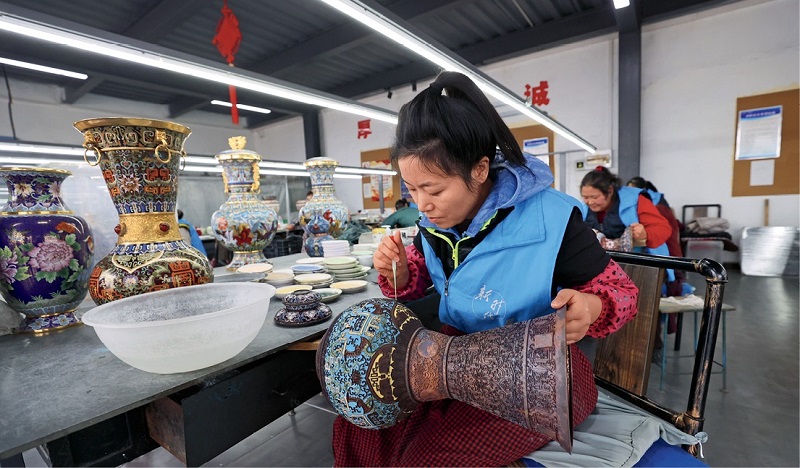
An artisan at the Beijing Liangshan Enamel Factory places enamel on a vase on December 10, 2024.
Chinese Cloisonné is the centuries-old handicraft of creating designs on copper bodies with colored-enamel placed within divisions made of copper wires, which are bent to follow the outline of decorative patterns. This form of art originated in the Arab world and was introduced to China during the late Yuan Dynasty (1271-1368), and since then it has become a favorite of the country’s emperors.
Over time, this craft developed into a distinctive traditional handicraft in the capital, Beijing. During Emperor Jingtai’s reign (1450–1457) in the Ming Dynasty (1368-1644), Chinese cloisonné reached its heyday, characterized by a blue color, taking on the name “Jingtai Blue.” Both the Ming and Qing (1644-1911) dynasties established imperial cloisonné workshops, and today, the Palace Museum in Beijing houses a large collection of cloisonné items from the Yuan, Ming, and Qing dynasties.
Cloisonné products are known for their intricate patterns and vibrant colors, made possible through bronze ware, enameling, and metal engraving techniques as well as traditional Chinese painting skills. In modern times, works of Chinese cloisonné have been displayed in numerous key exhibitions at home and abroad, and have been often presented as national gifts on important occasions. In 2006, Chinese cloisonné was added to China's first list of national intangible cultural heritage items.
While the finished products are stunning, the manufacturing process is complex, consisting of six major steps: creating metal bodies, bending wires, applying enamel, firing, polishing, and gilding gold.
Bending and placing wires demands great patience, as artisans use tweezers to shape fine metal wires into exquisite designs. Enamels made from finely ground minerals are prepared in 8 to 10 different shades for each hue, and then carefully filled into the cellular spaces. Even within a limited space, color gradient is necessary for creating a vivid, lifelike effect. Firing is another critical step, relying heavily on the artisan’s experience, since the firing time for products varies with their size and shape.
Today, this traditional art has been adapted to meet new market demands and modern aesthetics. At the Beijing Enamel Factory (also Beijing Cloisonné Art Museum), cloisonné items range from large ornaments like paintings and floor clocks to small jewelry pieces like necklaces and earrings. Also, cloisonné-based building designs have also emerged as a new trend, as seen in the decorations at Beijing Daxing International Airport and the Jingtai Station on Beijing Subway Line 14.